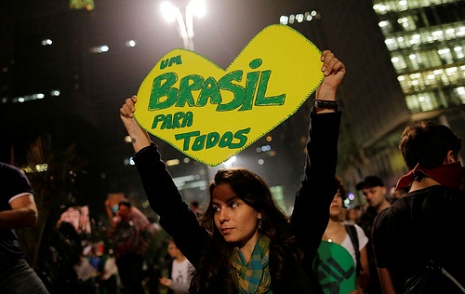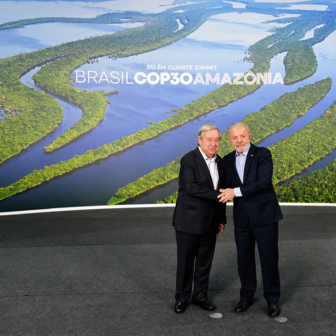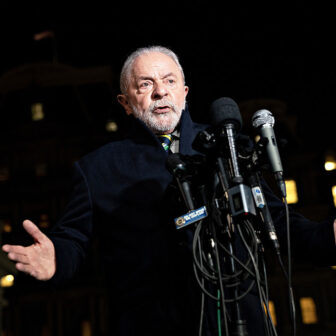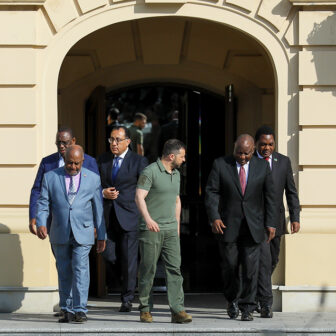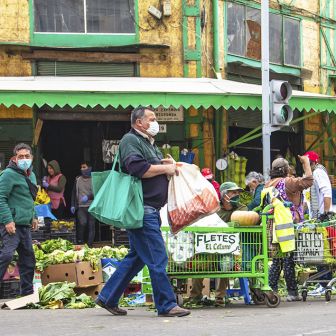FOR over a week, hundreds of thousands of people have been taking to the streets in Brazil’s main cities, including Rio de Janeiro, São Paulo, Brasilia and Belo Horizonte. The protests, which began as an isolated outburst over rising bus fares in São Paulo, have quickly grown into a much more widespread movement against the corruption and elitism of the political system and the excesses associated with staging the FIFA World Cup and the Olympics. They have caught many commentators by surprise, especially given Brazil’s image as a rising global power that has made great progress in lifting millions of people out of poverty over the past decade. Indeed, the World Cup and Olympics have, until now, been understood as marking the arrival of the country on the global stage, a shining example of the new Brazil.
As with any image, there is some truth to it. Under the leftist Workers’ Party (Partido dos Trabalhadores, or PT) governments of Luiz Inácio Lula da Silva (Lula) (2003–11) and his successor Dilma Rousseff (2011–), the Brazilian economy has grown steadily, if not spectacularly, and unlike governments in the past, the PT has made a concerted effort to spread some of the benefits of this growth to the margins of society.
The best-known of these efforts has been the Bolsa Família conditional cash transfer program, which has given a (minimal) income to a quarter of the population. But there have also been steady increases in the minimum wage and the extension of social security benefits and affordable credit to lower-income households. Moreover, under the PT, government spending on education has trebled, and the number of tertiary students has doubled, with the government obliging universities to reserve places for students from impoverished and non-white backgrounds.
There can be no denying the improvements in the lives of millions of people in the country. Rates of poverty have declined from 35 per cent of the population in 2003 to 21 per cent in 2009, and extreme poverty has more than halved from 15.2 per cent to 7.3 per cent. Over the past decade, as widely reported, forty million people have unquestionably entered the middle class, which for the first time represents more than half of the population (even if the methodology behind this claim remains contested).
What’s more, these material improvements have been coupled with an important shift in the political discourse under the PT, which has treated the country’s large, impoverished masses not as a threat to be managed out of sight, but as part of the citizenry of the country, deserving of rights just like the rest of society. Lula and Dilma have spoken constantly about building a new nation, and of including those previously left out of this process. The significance of such discourse and of a governing party that has its origins in the workers’ movement and until recently had been led by a person of humble origins such as Lula cannot be underestimated in a country that has only ever known rule by a tiny privileged minority. Many socioeconomic problems undoubtedly remain unsolved, but under the PT the Brazilian masses have been integrated into the social order and empowered on an unprecedented scale.
In a sense, the protests themselves illustrate the success of the government. Given the improvements in the lives of millions of people and a political discourse that champions the inclusion of all sectors of Brazilian society, it is no surprise that these sectors would now seek to exercise their rights to correct perceived wrongs.
It is here, however, that the limitations of the PT’s governance model begin to reveal themselves. While the PT may have started out as the party of the excluded that championed participatory democracy, it largely abandoned any attempt to reform the old elitist political system after it took power in 2003. Indeed, while Lula’s election was greeted with great enthusiasm by progressive forces both within the country and around the globe, Brazil remained firmly among the moderate governments elected throughout Latin America over the past decade, not only in economic but also in political terms. While others have experimented with participatory democracy measures and rewritten constitutions attempting to give citizens more of a direct stake in the political system, the PT largely remained wedded to the instruments of representative democracy, allowing citizens to vote every four years and then expecting them to leave the governing of the country in the hands of the political elite.
For a party that emerged from social movements and pioneered the process of participatory budgeting in its municipal administrations in the 1990s, this was quite a step backwards. It created tensions with social movements like the Landless Workers’ Movement (Movimento dos Trabalhadores Sem Terra, or MST), which had contributed significantly to Lula’s election, and indeed with the more radical and progressive grassroots of the PT itself, which expected the party at least to experiment with more participatory governing mechanisms. Instead, Lula and Dilma have set up corporatist bodies like the Economic and Social Development Council, which bring together representatives of business, unions, non-government organisations and social movements to “advise” the government on its overall policy direction. While the Council and other similar bodies have been hailed by the government as a means of “dialogue” between the state and society, the conversation has been rather one-sided – more a means of imposing the government’s developmental vision on the country, rather than a meaningful negotiation about priorities and directions. The fiasco over the cost blow-outs on the World Cup projects is a perfect illustration of this one-sided dialogue, with the government and FIFA largely pushing the projects through without any meaningful conversation about costs and benefits, except for the oft-repeated refrain that the Cup will represent the arrival of the country on the stage.
So the current protests represent both an explosion of immediate concerns and the longstanding tensions that have been overlooked by the many champions of Brazil’s success. As the protests show, these tensions can be ignored for a while, but not forever. Now, the bluff of the PT’s political project has been called. As the newly empowered sectors of Brazilian society push for change, they bump up against the limits of their inclusion: a political system that remains elite driven and controlled.
Where things go from here is anyone’s guess. President Dilma has responded to the protesters by praising them as a sign of Brazil’s strong democracy and acknowledging that they want more citizenship and participation, before reassuring them that her government is fighting to change the country in line with these demands. Given the nature of PT rule so far, there is little to indicate that such change involves serious reforms to the political system that would open up avenues for meaningful political participation. Whether assurances that the government is listening to the people are enough to mollify the protesters remains to be seen. •
